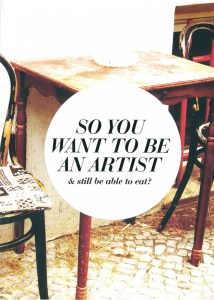MAKE A STATEMENT: The art of writing about your work
23/03/2016Below is an excerpt taken from the book, ‘So you want to be an artist & still be able to eat?’ that was published by Queensland Artworkers Alliance in 2010. It’s a really good resource that was written to walk artists through how to find work and get paid, how to establish and grow their arts practice and help with business, legal and financial advice.
This particular article discusses how to write artist statements, bios and curatorial statements and the differences between them.
MAKE A STATEMENT
The art of writing about your work
Written by Jessica Whiting
There is a popular perception that artists make the work and others write about it – let’s put that to rest right now. Artists are required to provide artist statements and bios when applying for almost everything, and curatorial statements when exhibiting and proposing exhibitions. Despite being so frequently demanded of them, many artists find it difficult to write about their work. If you want to communicate and promote your work to others, you will need to brush up on your writing skills.
Artist Statements & Bios
An artist statement is an introduction to and overview of your practice. The content of an artist statement should include the materials you use, your technique and your style. It should also include the influences on your practice, the ideas that drive your practice, and how you articulate these ideas in your work. It’s handy to have both a short and long version of your artist statement, but it must be no longer than one page in length. Some galleries will ask for an artist bio rather than an artist statement. The content of a bio is a combination of your artist statement and your CV. It is the highlights of your CV, written out in several paragraphs. The artist statement and artist bio can be written in first or third person. The tense that you use depends on the perception of yourself that you would like to give and the type of gallery you are writing to. Third person allows objectivity and distance, which is desired at more serious galleries. First person allows intimacy and personality, which may be desired at a gallery that promotes the personable. Both documents need to be revised and updated throughout your career. Do this after each time you exhibit or each time you produce a new body of work.
Curatorial Statements
A curatorial statement is, generally, two or three paragraphs about a particular body of work, rather than your entire practice. It places that body of work within the context of your practice. Curatorial statements are often displayed on a gallery wall during an exhibition or printed on sheets of paper that are available to visitors to the gallery. They can be included in exhibition proposals for gallery spaces, and grant submissions for exhibitions. Curatorial statements should be written in the third person. In fact, it is not uncommon for artists not to write their own at all, as some prefer others to write the statement for them. If you exhibit in a regional or public gallery, the curator of the gallery may write the curatorial statement for you. Even so, it’s a good idea to draft a few so you have practice writing about and articulating your work. If you intend to select a writer to write one for you, choose someone who has an in-depth understanding of your work.
Writing About Your Work
When exhibiting, one of these three documents will be available for the public to read. You should adjust the language and even the content of your writing to suit your anticipated audience. This means that you must have some sense of the audience of the gallery in which you are exhibiting. When writing to the audiences of large, public or commercial galleries, it may be more appropriate to use formal, academic language. While writing for smaller, community or traditional galleries, it may be more appropriate to write in a more casual style. Read other people’s writing to help you develop an understanding of how to write to different audiences. You can develop your own writing by paying attention to the way that others talk about your work. What questions do they ask? The answers to these questions could inform the content of your writing. What words and phrases do they use? If you read or hear a word or phrase that you like, write it down in your journal or stick it on your wall. In this way, you are developing a vocabulary for your work and writing about it will become natural.
If you are interested in purchasing a copy of the book, Flying Arts sell them: www.flyingarts.org.au/art-supplies-books












